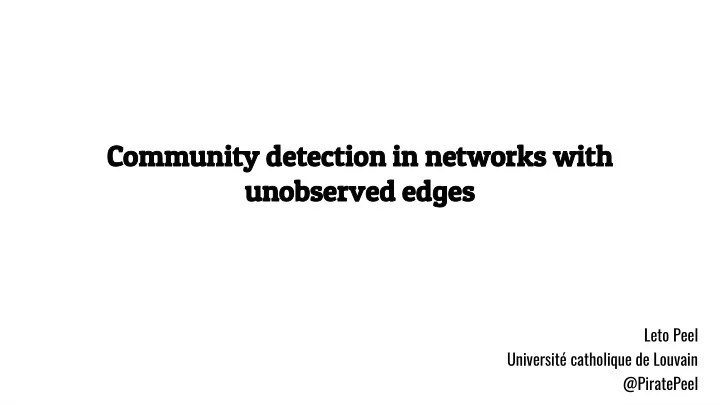

Com ommunity de ty detecti tection i in n netw twor orks w with th unobser erved ed edg edges es Leto Peel Université catholique de Louvain @PiratePeel
Community detection Aim: partition the network according similarity of link structure
Community detection Aim: partition the network according similarity of link structure But we observe signals on nodes and no links!
Motivating examples... Identify assets whose prices vary coherently to better manage risk
Motivating examples... Identify regions of the brain to predict the onset of psychosis and learn about the ageing of the brain Identify assets whose prices vary coherently to better manage risk
Motivating examples... Identify regions of the brain to predict the onset of psychosis and learn about the ageing of the brain Identify assets whose prices vary Identify climate zones to better coherently to better manage risk understand factors afecting our climate
Is there really a network?
Is there really a network? We don’t have to directly observe something to believe it is true
Common practise • Calculate pairwise correlations between signals (e.g. Pearson’s). • Threshold (and Binarize) the matrix of correlations. • Perform community detection on this (notional) network
Problems • This procedure commonly invokes point-estimates at each step – Does not capture the uncertainty of individual links
Problems • This procedure commonly invokes point-estimates at each step – Does not capture the uncertainty of individual links • Unclear how to include missing data. • No intrinsic/clear notion of the right number of communities.
The signals we observe from many nodes are driven by a few latent factors
The signals we observe from many nodes are driven by a few latent factors Notion of a community is: a group of nodes that infuenced similarly by the latent factors
Observed time series Latent factor Factor loadings time series
Community mean Community precision
Generated Inferred Lower bound on the Diference between marginal likelihood (ELBO) K generated and K inferred
US cities climate data Koppen climate zones inferred climate zones
What happened to the network? • Since we skip explicit interpretation of A our inference framework is basically a Bayesian (time-series) clustering. • One can re-interpret AA T as a network, or interpret distances between time-series in the latent-space as links in a network, but this is optional.
EDGES? WHERE WE’RE GOING, WE DON’T NEED “EDGES”
Advertisement Applications now open! http://wwcs2019.org/ February 4-8 th 2019 Zakopane, Poland
In collaboration with... Come to my other talks: “Graph-based semi-supervised learning for complex networks” Wed 16:30 Room 10 “Multiscale mixing patterns in networks” Till Nick Renaud Thur 12:10 Room 3 Hofmann Jones Lambiotte Preprint available: arXiv:1808.06079 Contact: leto.peel@uclouvain.be @PiratePeel
Recommend
More recommend